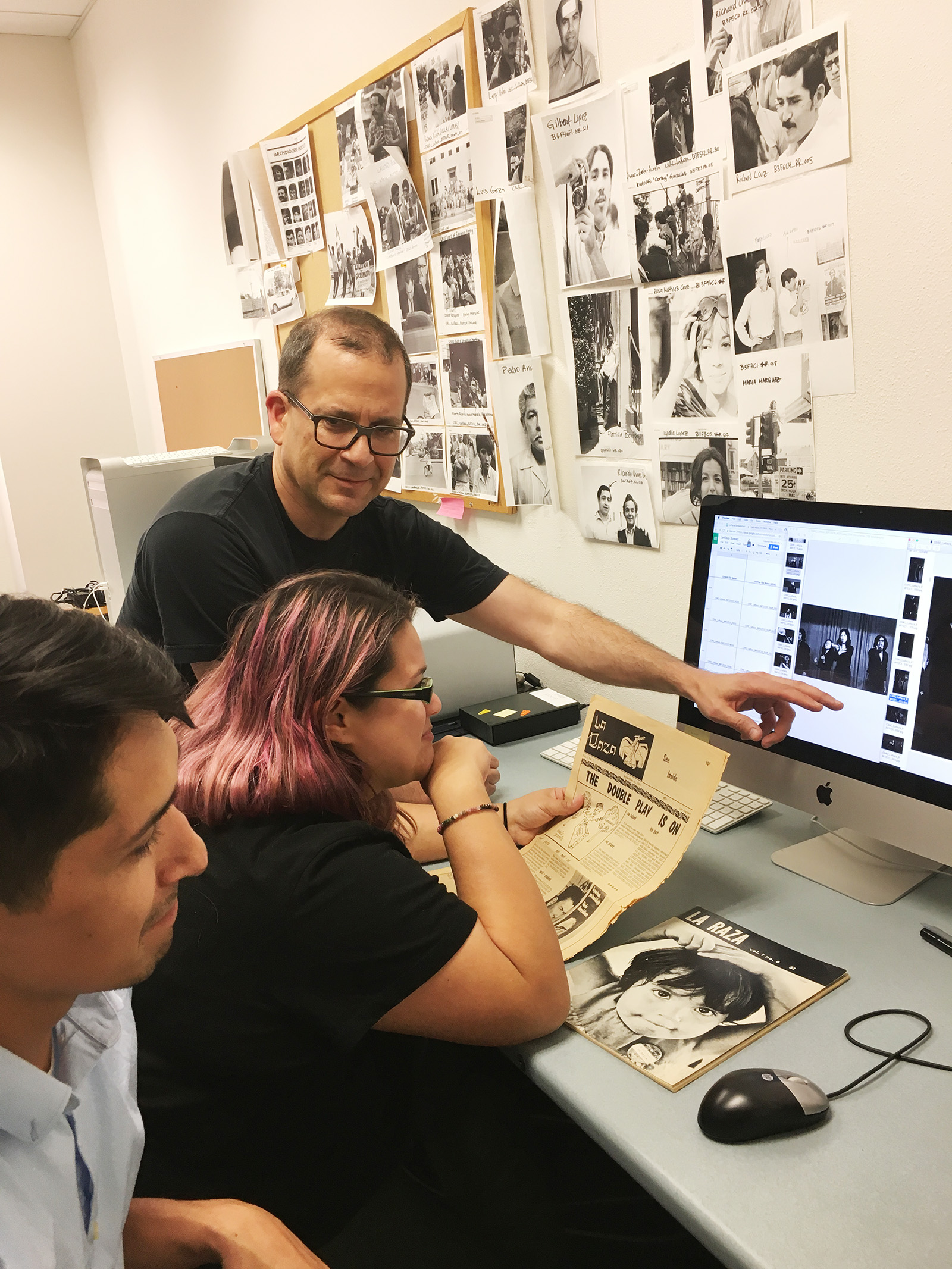Autry Museum photo exhibition highlights Mexican-American community

Michael Aguilar (left), Xaviera Flores (center) and Chon Noriega (right), organize some of the images featured at the LA RAZA exhibition, which opened Sept. 16 and will run through early 2019. (Courtesy of Cheyenne Lentz)
By Sally Lee
Sept. 21, 2017 7:23 p.m.
The photographers of “La Raza” sifted through thousands of memories embedded in the images they had taken 50 years ago.
“La Raza,” a Chicano newspaper turned magazine that ran from 1967 to 1977, documented the Mexican-American community’s strife for equal rights through articles and photographs of its volunteer photographers.
But 50 years after its conception, the magazine’s volunteer photographers realized the photos should be preserved by an institution to prevent them from being forgotten by future generations. Together, they decided to send them to UCLA’s Chicano Research Center.
UCLA’s Chicano Studies Research Center has loaned 25,000 of the images to the Autry Museum of the American West. As part of the Getty Center’s Pacific Standard Time initiative, the LA RAZA exhibition opened Sept. 16 and will run through early 2019.
“The photographs depict a misrepresented community, fighting against the unequal access to education, to roads and employment,” said Chon Noriega, the director of the UCLA Chicano Research Center and a UCLA School of Theater, Film and Television professor.
“La Raza” is the largest documentation effort of El Movimiento, the Chicano Movement, during the 1960s and ‘70s, without government, public or nonprofit support, Noriega said. The purpose of the archive and exhibition is to preserve an essential moment in history by using photos from the time, he added.
In the 1960s and ‘70s, outside of the mainstream media, there were few presses and networks that covered Mexican-American communities, Noriega said. “La Raza” was created as an alternative press, giving Mexican-Americans a collective voice.
“The images captured a sense of being human and human compassion,” Noriega said. “There’s something really peaceful and personal about them.”
He added some of the more memorable photos include an image of smiling Mexican-American children on bicycles and a crude but heartwarming photo of a wounded young adult being cared for by his brothers.
However, while the photographs depict children from over more than half a century ago, Noriega said the photos are timely now more than ever.
“Now we have the same issues as (during the Chicano Movement): immigration, access to education, civil and human rights,” he said. “The only difference is (that) back then it was about a minority population, but now it’s a majority population, so the issues are several magnitudes larger today.”
Amy Scott, the co-curator for the exhibition, said she also finds the archive important because it provides an interesting snapshot of Los Angeles during a pivotal era. She added the archive illustrates why the past should not be forgotten.
Scott said that photos depicting children are especially personal to her because she became a mother during the archive curation process.
“The children are representative of hope for the future and of innocence, but there’s poignancy in that they experienced racism firsthand through the pervasive biases in the education system and other unequal opportunities,” she said. “Children are also important symbolically, as they are the heirs to the next generation.”
The archive’s photos were all taken by volunteers for “La Raza,” which included some UCLA alumni such as Luis Garza, who also helped curate the photos for the archive.
The images and the exhibition openly portray the Latino community’s empowerment and resilience, Garza said, but behind the photos, the photographers themselves also developed a strong connection. Though the photographers and journalists came from all walks of life, their collaboration on the project created a strong collective bond, he added.
“We mentored one another, respected one another, whether we were with a camera or pen in hand,” Garza said.
A mixture of printed and framed images, digital projections, and an interactive large-scale touch-screen are displayed on the walls of the exhibition, allowing piece-by-piece storytelling, as each image is a part of the whole story, he said.
“You have the African-American (Civil) Rights Movement, women’s rights, and more,” Garza said. “We are representing just a part of the larger civil rights movement.”


